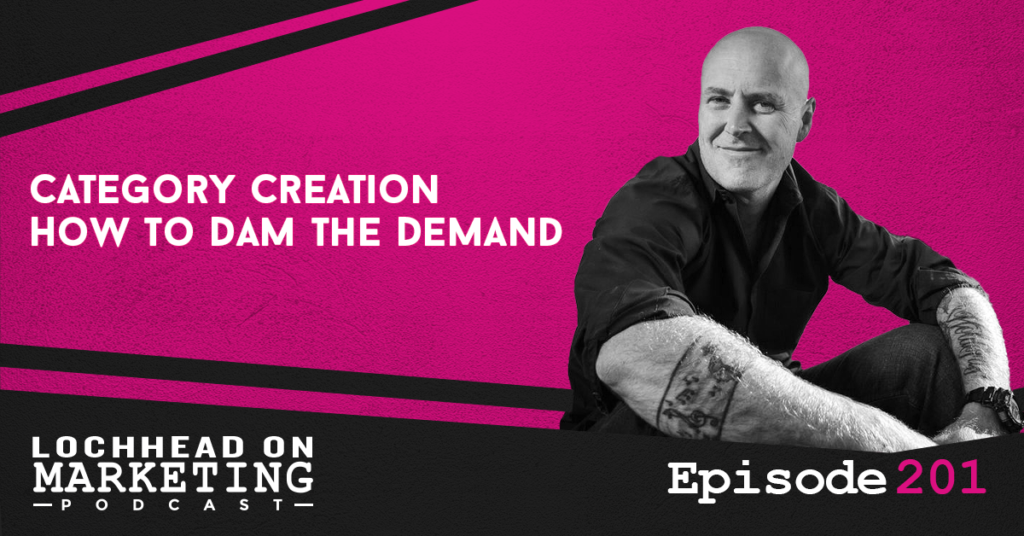201 Category Creation: How To Dam The Demand

Podcast (lochheadonmarketing): Play in new window | Download (Duration: 11:42 — 8.0MB) | Embed
Subscribe: Apple Podcasts | Spotify | RSS | More
On this episode of Lochhead of Marketing, we review a powerful strategy that has the potential to revolutionize how you approach marketing and demand creation for your product or service. We call this strategy “damming the demand,” and it’s all about redirecting existing consumer desire to carve out a new category that you can dominate.
If you’re not convinced, check out how these giants in the industry have utilized this strategy to their advantage by creating demand in an already existing market.
Welcome to Lochhead on Marketing. The number one charting marketing podcast for marketers, category designers, and entrepreneurs with a different mind.
Dam the Demand
Traditional marketing often focuses on capturing the demand that already exists. It’s about finding a place in the market and filling the needs of consumers who are already looking for solutions. But what if you could do more than just meet existing demand? What if you could create a whole new category of demand?
That’s where the concept of “damming the demand” comes in. It’s a strategy that sits between traditional marketing and category design. Instead of just capturing demand or creating it from scratch, you harness the existing demand and redirect it, creating a new space for your product or service.
Lessons from Tech Titans
Let’s look at some legendary examples to understand this better. Marc Benioff, the founder of Salesforce.com, didn’t just create a cloud CRM; he dammed the demand for traditional on-premise CRM solutions. By evangelizing the benefits of cloud-based CRM, he forced a debate in the market, making businesses choose between the old on-premise solutions and the new, more flexible cloud options. This didn’t just shift the demand—it expanded it, as more and more businesses began to see the value in cloud-based applications beyond CRM.
In the B2C world, Peloton took a similar approach. They saw the demand for spin classes and dammed it by offering an alternative: high-quality home fitness. By doing so, they didn’t just capture the existing market for spin classes; they expanded it to include people who wanted the convenience of working out at home. This created a new category of home fitness solutions that has grown exponentially.
This isn’t a new phenomenon. History is rich with examples of demand damming. Consider Henry Ford, who redirected the demand from horse and buggies to the “horseless carriage,” or Marty Cooper, who shifted the demand from landline phones to the “wireless phone” category. These visionaries didn’t just create products; they created movements that changed the landscape of their respective industries.
The Strategy in Action
So, how can you apply this strategy to your business?
First, identify the existing demand that you can dam. Look for areas where consumers are already spending their money but might be open to a new, better solution. Once you’ve dammed the demand, use it to drive revenue in the near term. Then, leverage this demand to expand and create a new category that you can lead.
Damming the demand is a potent strategy for any company looking to not just compete but dominate a new market category. By redirecting existing demand, you can create a new demand for your category, driving growth and market expansion. It’s a bold move, but as we’ve seen from the likes of Salesforce and Peloton, it’s a move that can redefine your industry and cement your place in history.
Bio
Don’t forget to grab a copy (or gift!) of one of our best-selling books:
Snow Leopard: How Legendary Writers Create A Category Of One
The Category Design Toolkit: Beyond Marketing: 15 Frameworks For Creating & Dominating Your Niche
A Marketer’s Guide To Category Design: How To Escape The “Better” Trap, Dam The Demand, And Launch A Lightning Strike Strategy
 The 22 Laws of Category Design: Name & Claim Your Niche, Share Your POV, And Move The World From Where It Is To Somewhere Different
The 22 Laws of Category Design: Name & Claim Your Niche, Share Your POV, And Move The World From Where It Is To Somewhere Different**NEW!** The B2B Tech Marketer’s Guide To Category Design: How To Engineer Your Market, Find What Makes You Different, And Become A Category Queen
We hope you enjoyed this episode of Lochhead on Marketing™! Christopher loves hearing from his listeners. Feel free to email him, connect on Facebook, Twitter, Instagram, and subscribe on iTunes!

